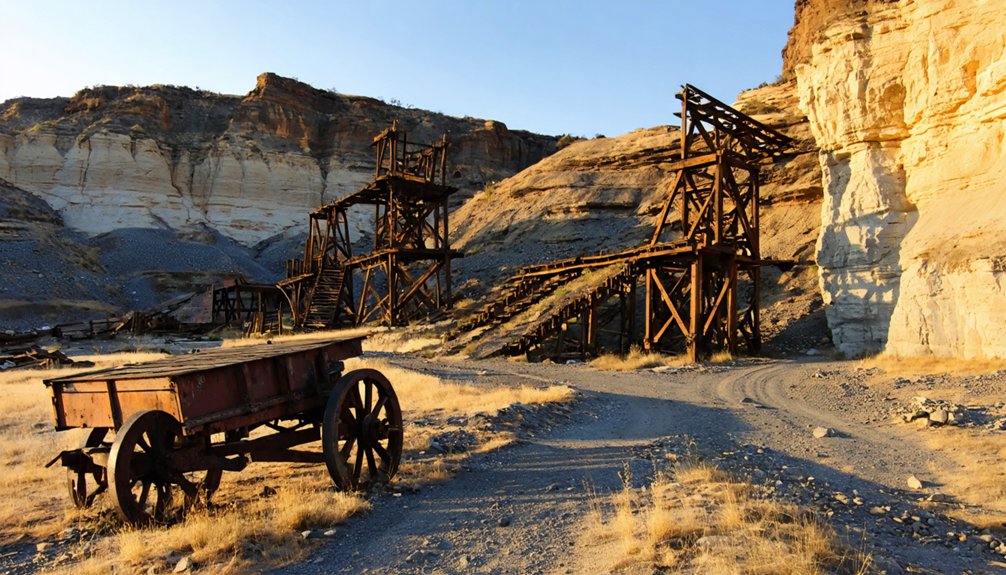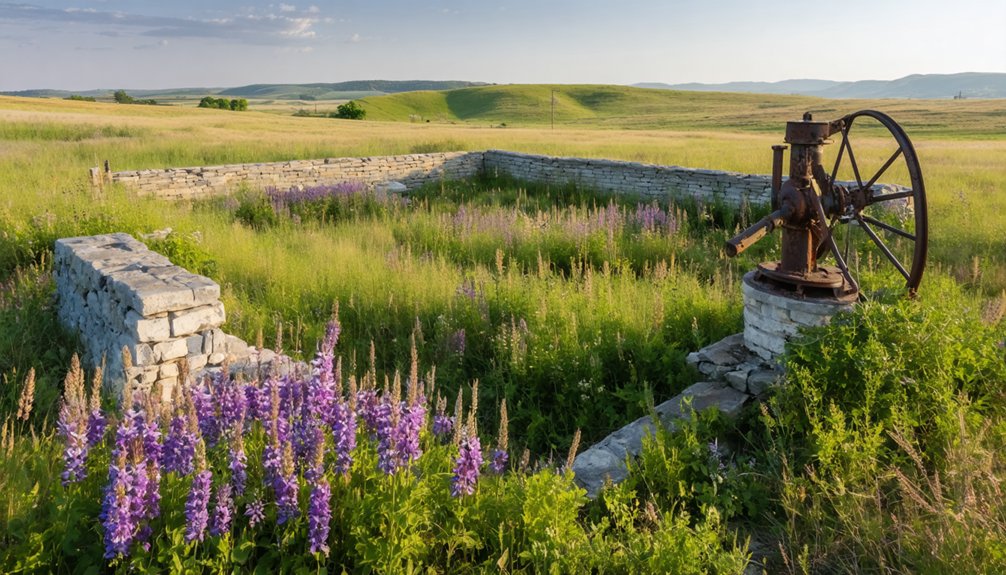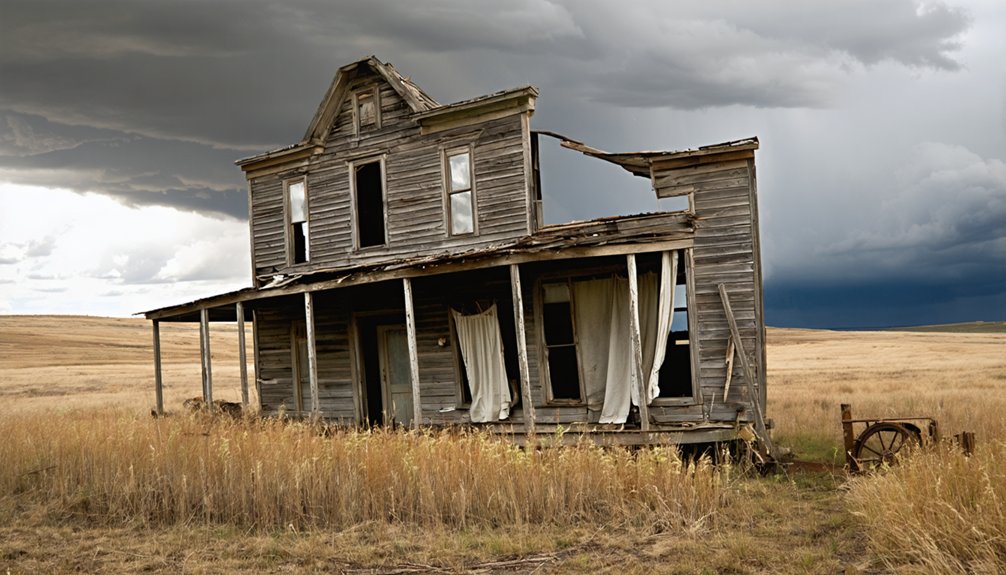You’ll find Hornblende Camp nestled in Pennington County’s Black Hills region, where it emerged in 1899 during the area’s gold rush. Named for its rich hornblende mineral deposits, this mining settlement utilized advanced hoisting systems and mechanized equipment to extract gold, silver, and copper. The town faced harsh conditions and economic challenges before its abandonment in 1915. Today, nature has reclaimed the site, though its industrial legacy holds fascinating untold stories of Black Hills mining innovation.
Key Takeaways
- Hornblende Camp was established in 1899 in Pennington County, South Dakota, named after the abundant hornblende mineral deposits in the area.
- The mining town flourished briefly around hard rock mining operations, hosting miners and their families during the Black Hills gold rush.
- Mining operations focused on gold extraction from quartz veins but also yielded silver and copper between 1899 and 1915.
- The town was abandoned in 1915 due to declining mineral yields, high operational costs, and deteriorating infrastructure.
- Today, the ghost town site has been completely reclaimed by nature, with no remaining structures or historical markers visible.
Origins and Settlement of Hornblende Camp
While prospectors were drawn to many promising locations throughout the Black Hills region during the late 1800s, Hornblende Camp emerged as a distinct settlement in Pennington County, South Dakota around 1899.
The camp’s name originated from the abundant hornblende mineral deposits found in the area’s igneous and metamorphic rocks, which attracted miners seeking their fortunes in gold and other valuable minerals.
Settlement patterns developed around the hard rock mining operations, with miners and their families establishing a small but determined community. Like many settlers of that era, residents faced harsh weather conditions while starting their new lives from scratch.
You’ll find that the camp’s early community dynamics centered on essential infrastructure, including a post office and temporary dwellings.
Historical records show variant spellings, including “Horneblende,” reflecting the informal nature of these frontier mining settlements during the Black Hills Gold Rush era.
Like many of the over six hundred ghost towns in the Black Hills, Hornblende Camp gradually declined as mining operations became less profitable.
Life During the Mining Boom
The influx of miners into Hornblende Camp brought dramatic changes to the once-quiet Black Hills landscape. You’d have found a bustling community where social dynamics shifted daily as prospectors, merchants, and families from diverse backgrounds established themselves in hastily built structures.
The town’s economic fluctuations mirrored the unpredictable nature of mining success, with fortunes made and lost on the turn of a shovel.
Life centered around the saloons and entertainment venues, where you could’ve witnessed the mixing of various ethnic groups sharing stories of their latest strikes.
While the promise of wealth drew many to Hornblende Camp, you’d have also encountered the harsh realities of frontier life – limited law enforcement, environmental challenges, and the constant risk of economic downturns when mineral yields decreased.
Mining Operations and Techniques

Deep beneath Hornblende Camp‘s rugged surface, miners deployed sophisticated hoisting systems and mechanized equipment to extract precious metals from the region’s complex mineral deposits.
Similar to the historic Homestake Mine operations, the site utilized extensive underground mining techniques that helped shape South Dakota’s mineral production legacy.
You’ll find evidence of mining equipment innovations that included powerful 75-horsepower engines capable of lifting two tons of ore at 400 feet per minute using steel cables up to 2.75 inches thick.
The ore processing techniques focused primarily on gold extraction from quartz veins and sulfide-rich deposits, with silver produced as a valuable byproduct at a 5:1 ratio.
Miners sank shafts beyond 1,000 feet to reach the richest veins, while massive pumps moved 5,000 gallons of water per hour to keep the workings dry.
The operation also recovered strategic minerals like lithium, beryl, and tantalum from pegmatite deposits, supporting both civilian industry and military needs.
The mine’s proximity to Myersville hamlet provided convenient access to additional labor and supplies for the extensive mining operations.
Notable Structures and Buildings
Modern visitors to Hornblende Camp will find little evidence of its once-bustling mining operations, as this “barren” ghost town has largely reverted to its natural state.
You won’t find any standing buildings at the site today – no stores, saloons, or community facilities remain to hint at the daily lives of its former inhabitants.
The mining infrastructure that once defined this camp has virtually disappeared.
While the area likely featured wooden structures typical of 19th-century mining settlements, including simple housing and basic industrial installations, these have long since vanished.
If you’re exploring the site, you might discover subtle traces of the past, such as foundation depressions or scattered debris, but the landscape has largely reclaimed what was once a frontier mining community. Like many abandoned sites, the area has transformed into empty pasture land over time.
The Decline and Abandonment
As mining operations faltered in Hornblende Camp between 1899 and 1915, you’d find workers and their families steadily departing from this Black Hills settlement.
The camp’s population dwindled rapidly once the extraction of minerals proved economically unfeasible, with high operational costs and declining mineral prices forcing mine closures. Much like the impact of the Great Depression on Capa, economic factors devastated the community’s sustainability.
You can trace the exodus patterns through historical records, which show how the workforce dispersed to other mining towns or left the industry altogether, leaving Hornblende Camp to fade into abandonment. Like many South Dakota mining towns that once thrived during the gold rush era, Hornblende Camp’s ultimate fate was sealed by diminishing profits.
Mining Operations Cease
Environmental regulations struck a devastating blow to Hornblende Camp’s mining operations in the early 1990s.
You’ll find that South Dakota’s new restrictions limiting surface mines to 320 acres, combined with strict cyanide control measures, made continued operations nearly impossible.
The regulatory challenges hit hard when neighboring Brohm Mining’s contamination issues brought heightened scrutiny to all Black Hills mines.
Economic downturns didn’t help either.
You’re looking at a perfect storm: declining ore grades, costly environmental compliance, and fluctuating gold prices made profitable extraction increasingly difficult.
The camp’s technological limitations became painfully apparent as its dated machinery couldn’t compete with modern methods.
The complex sulfide-rich ore bodies required expensive processing that the operation simply couldn’t sustain, leading to its inevitable closure.
Geologists studying the site discovered large deposits of dark inosilicate minerals typical of the region’s metamorphic formations.
Population Exodus Patterns
The mass departure from Hornblende Camp began shortly after the mining operations ceased, following a predictable pattern seen in many Black Hills mining communities.
You’d have witnessed the population dynamics shift dramatically as younger residents were the first to leave, seeking better opportunities in more prosperous areas. The exodus accelerated as essential services began to falter – first the general store closed, then the post office, and finally the schoolhouse.
Similar to how mining continued until 1920s in other regional towns like Spokane, Hornblende Camp’s decline followed the depletion of its mineral resources. The region yielded unexpected discoveries of silver and copper rather than the gold originally sought by prospectors. The primary migration drivers included the deteriorating infrastructure, with roads becoming increasingly difficult to maintain, and the lack of economic alternatives to replace the mining industry.
Families with school-age children departed next, followed by skilled workers, leaving behind an aging population that eventually relocated to nearby towns with better access to healthcare and modern amenities.
Geographic Location and Terrain
Located within Pennington County’s rugged Black Hills region, Hornblende Camp stands as a tribute to South Dakota’s mining heritage amidst steep, mountainous terrain.
You’ll find the site nestled in an area where elevations range from 3,200 to 7,242 feet, surrounded by the vast Black Hills National Forest. The camp’s remote location presents significant topographic challenges, with narrow valleys carved through ancient Precambrian rock formations.
The geological features that drew miners here include exposed mineralized zones rich in hornblende and other valuable minerals. The camp sits among some of North America’s oldest exposed rocks, dating back 2.5 billion years.
Ancient mineralized deposits and 2.5-billion-year-old rock formations made this site a prime target for early mining operations.
Today, you’ll encounter a landscape dominated by ponderosa pine forests, rocky outcrops, and the historic remnants of mining operations that shaped this rugged terrain.
Present-Day Site Conditions

Following its glory days amid the geological riches of the Black Hills, Hornblende Camp now stands as a barren memorial to South Dakota’s mining past.
Since its abandonment in 1915, nature has reclaimed the site, erasing virtually all traces of human habitation. You’ll find no remaining structures or historical markers at this remote location, which has been absorbed into the nearby community of Maitland.
No site restoration efforts have been documented, and environmental assessment shows the area has largely reverted to its natural state.
If you’re planning to visit, be aware that the camp’s remote location and lack of infrastructure make it challenging to access. With no buildings, foundations, or distinct features remaining, the site serves primarily as a reflection of the region’s boom-and-bust mining heritage.
Historical Significance in Black Hills Mining
You’ll find Hornblende Camp‘s origins deeply rooted in the Black Hills gold rush, established in 1899 as part of the region’s expanding mining frontier.
The camp played a crucial role in the area’s economic growth through its placer gold operations, contributing to the Black Hills’ reputation as a significant mining district.
As one of several mining settlements that dotted the landscape near Deadwood Creek, Hornblende Camp represented the broader industrial development that transformed the Black Hills into a major mineral production hub during the early 20th century.
Mining Camp Origins 1899
The establishment of Hornblende Camp in 1899 marked a significant addition to the Black Hills‘ thriving mining frontier during the late 19th century gold boom.
You’ll find its origins deeply rooted in the region’s rich mineral deposits, particularly near Deadwood Creek, where early prospectors discovered promising gold veins alongside the camp’s namesake hornblende minerals.
Like many mining camps that sprang up after Custer’s 1874 expedition, Hornblende’s story reflects the adventurous spirit of frontier mining techniques.
The camp flourished briefly until 1915, when dwindling resources led to its abandonment.
Today, it stands as a ghost town, a monument to the boom-and-bust cycle that characterized Black Hills mining communities.
Its location near significant gold mining operations made it an ideal settlement for miners seeking their fortune in the region’s complex geological formations.
Gold Rush Economic Impact
While Hornblende Camp represented just one small piece of the Black Hills’ mining story, gold mining’s broader economic impact reshaped South Dakota’s financial landscape for over a century.
You’ll find the industry’s influence reflected in the staggering figures: by 1995, five major mines generated over $54 million in annual payroll and $13 million in state and local taxes. The legendary Homestake Mine alone produced 40 million ounces of gold during its 125-year run.
The pursuit of economic sustainability through mining created lasting prosperity in Lawrence County, where mining wages made up 30% of total earnings.
Even as tourism emerged as an important industry, gold mining remained the region’s largest private employer, providing essential tax revenue that funded public services and infrastructure development.
Black Hills Industry Hub
Beyond gold’s economic footprint, Black Hills mining carved out a complex industrial legacy through its diverse mineral wealth and technological advancement.
You’ll find this region’s true significance in its remarkable variety of minerals and pioneering mining technology that transformed America’s industrial capabilities.
- The Black Hills’ sprawling 60-by-125-mile uplift yielded strategic minerals like beryllium, tantalum, and lithium that proved essential for wartime manufacturing.
- Mining technology evolved rapidly, with innovations like the massive 300-horsepower Corliss engine and specialized Hendy concentrators revolutionizing ore processing.
- Key mining districts including Keystone, Custer, Hill City, and Tinton established the region as a powerhouse for pegmatite and precious metal extraction.
This industrial heritage, valued at over $17 billion in modern terms, showcases how the Black Hills became a cornerstone of American mineral production and technological progress.
Frequently Asked Questions
Were Any Major Accidents or Disasters Recorded at Hornblende Camp?
You won’t find definitive accident reports or disaster management records from this location. While mining hazards existed, historical documentation hasn’t preserved specific incidents that occurred in the camp’s operational period.
What Was the Peak Population of Hornblende Camp During Its Existence?
Pioneering population growth during the mining boom brought you a peak community of 400 residents, marking the height of prosperity when miners, laborers, and support workers called this rugged settlement home.
Did Any Famous Historical Figures Visit or Stay in Hornblende Camp?
You won’t find evidence of any famous visitors in historical records. While other Black Hills towns attracted historically significant figures, research shows no documented notable personalities ever stayed in this mining camp.
What Types of Minerals Besides Gold Were Mined at Hornblende Camp?
You’ll find incredible mineral diversity in the pegmatite deposits, where miners extracted lithium from spodumene and lepidolite, plus feldspar, beryl, columbite-tantalite, mica, and tin from cassiterite using various mining techniques.
Were There Any Schools or Churches Established in Hornblende Camp?
You won’t find documented school history or church services in this camp. Residents likely relied on neighboring towns for education and worship, as the camp focused primarily on mining operations.
References
- https://www.sdpb.org/rural-life-and-history/2023-08-21/some-black-hills-ghost-towns-and-their-origins
- https://www.youtube.com/watch?v=Glucs_Rq8Xs
- https://www.sdhspress.com/journal/south-dakota-history-2-2/some-black-hills-ghost-towns-and-their-origins/vol-02-no-2-some-black-hills-ghost-towns-and-their-origins.pdf
- https://www.powderhouselodge.com/black-hills-attractions/fun-attractions/ghost-towns-of-western-south-dakota/
- https://www.youtube.com/watch?v=_0WNYsFLSLA
- https://www.blackhillsbadlands.com/blog/post/old-west-legends-mines-ghost-towns-route-reimagined/
- https://en.wikipedia.org/wiki/List_of_ghost_towns_in_South_Dakota
- https://kids.kiddle.co/List_of_ghost_towns_in_South_Dakota
- https://icatchshadows.com/okaton-and-cottonwood-a-photographic-visit-to-two-south-dakota-ghost-towns/
- https://history.sd.gov/museum/docs/Mining.pdf



